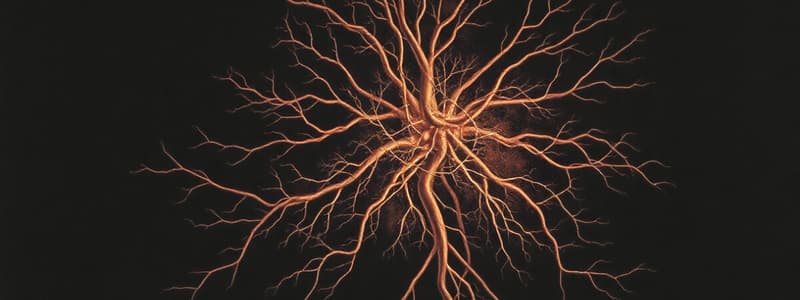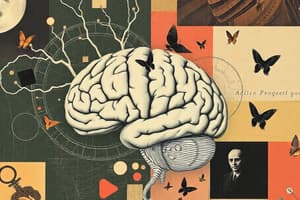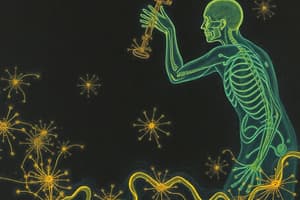Podcast
Questions and Answers
How does the nervous system respond to stimuli?
How does the nervous system respond to stimuli?
- By signaling for cell division and growth.
- By gathering and processing information to elicit a response. (correct)
- By releasing hormones that cause a reaction.
- By initiating the digestion of nutrients for energy.
What is the primary function of a neuron?
What is the primary function of a neuron?
- To provide structural support to body organs.
- To produce hormones that regulate body functions.
- To transmit electrical signals, enabling the body to respond to stimuli. (correct)
- To break down nutrients for energy production.
Which components constitute the Central Nervous System (CNS)?
Which components constitute the Central Nervous System (CNS)?
- Peripheral nerves and autonomic nerves.
- Brain and peripheral nerves.
- Spinal cord and peripheral nerves.
- Brain and spinal cord. (correct)
What role do myelin sheaths play in neuron function?
What role do myelin sheaths play in neuron function?
What is the role of neurotransmitters in synaptic transmission?
What is the role of neurotransmitters in synaptic transmission?
How do interneurons contribute to nervous system function?
How do interneurons contribute to nervous system function?
Which bodily functions are regulated by the autonomic nervous system?
Which bodily functions are regulated by the autonomic nervous system?
What distinguishes the sympathetic nervous system from the parasympathetic nervous system?
What distinguishes the sympathetic nervous system from the parasympathetic nervous system?
How does the endocrine system maintain homeostasis in the body?
How does the endocrine system maintain homeostasis in the body?
What is the key difference between negative and positive feedback mechanisms?
What is the key difference between negative and positive feedback mechanisms?
Which endocrine gland directly links the nervous and endocrine systems, playing a key role in maintaining body homeostasis?
Which endocrine gland directly links the nervous and endocrine systems, playing a key role in maintaining body homeostasis?
What is the primary role of the anterior pituitary gland?
What is the primary role of the anterior pituitary gland?
In a stress response, how do the nervous and endocrine systems coordinate to restore balance?
In a stress response, how do the nervous and endocrine systems coordinate to restore balance?
What is a key difference in signaling between the nervous and endocrine systems?
What is a key difference in signaling between the nervous and endocrine systems?
How do plants respond to external stimuli?
How do plants respond to external stimuli?
What is the role of plant responses in their survival?
What is the role of plant responses in their survival?
How does Mimosa Pudica (sensitive plant) respond to touch?
How does Mimosa Pudica (sensitive plant) respond to touch?
What is the function of stomata in plant response?
What is the function of stomata in plant response?
How do some plants defend against pathogens and predators?
How do some plants defend against pathogens and predators?
What is tropism in plants?
What is tropism in plants?
In the context of plant tropism, what role do roots typically play?
In the context of plant tropism, what role do roots typically play?
What function do hormones serve in plants?
What function do hormones serve in plants?
Which plant hormone is responsible for the stimulation of stem elongation, root growth, cell differentiation, and branching?
Which plant hormone is responsible for the stimulation of stem elongation, root growth, cell differentiation, and branching?
What processes do cytokinins affect on plants?
What processes do cytokinins affect on plants?
Which of the following is a primary function of gibberellins in plants?
Which of the following is a primary function of gibberellins in plants?
How do brassinosteroids primarily affect plant growth and development?
How do brassinosteroids primarily affect plant growth and development?
What is the main function of abscisic acid (ABA) in plants?
What is the main function of abscisic acid (ABA) in plants?
Which hormone promotes fruit ripening in plants?
Which hormone promotes fruit ripening in plants?
What do the nervous and endocrine systems regulate together?
What do the nervous and endocrine systems regulate together?
Flashcards
Nervous System
Nervous System
Gathers and processes information, eliciting responses to stimuli.
Neurons
Neurons
Specialized cells in the nervous system that control and send information.
Central Nervous System (CNS)
Central Nervous System (CNS)
Brain and spinal cord; the body's control center.
Peripheral Nervous System (PNS)
Peripheral Nervous System (PNS)
Signup and view all the flashcards
Neuron
Neuron
Signup and view all the flashcards
Dendrites
Dendrites
Signup and view all the flashcards
Soma
Soma
Signup and view all the flashcards
Axon
Axon
Signup and view all the flashcards
Myelin Sheaths
Myelin Sheaths
Signup and view all the flashcards
Axon Terminal
Axon Terminal
Signup and view all the flashcards
Synapse
Synapse
Signup and view all the flashcards
Neurotransmitters
Neurotransmitters
Signup and view all the flashcards
Sensory Neurons
Sensory Neurons
Signup and view all the flashcards
Interneurons
Interneurons
Signup and view all the flashcards
Motor Neurons
Motor Neurons
Signup and view all the flashcards
Sensory-Somatic Nervous System
Sensory-Somatic Nervous System
Signup and view all the flashcards
Autonomic Nervous System
Autonomic Nervous System
Signup and view all the flashcards
Sympathetic Nervous System
Sympathetic Nervous System
Signup and view all the flashcards
Parasympathetic Nervous System
Parasympathetic Nervous System
Signup and view all the flashcards
Endocrine System
Endocrine System
Signup and view all the flashcards
Feedback Mechanism
Feedback Mechanism
Signup and view all the flashcards
Negative Feedback
Negative Feedback
Signup and view all the flashcards
Positive Feedback
Positive Feedback
Signup and view all the flashcards
Hypothalamus
Hypothalamus
Signup and view all the flashcards
Tropism
Tropism
Signup and view all the flashcards
Sunflower
Sunflower
Signup and view all the flashcards
Plant Hormones
Plant Hormones
Signup and view all the flashcards
Cytokinins
Cytokinins
Signup and view all the flashcards
Abscisic Acid
Abscisic Acid
Signup and view all the flashcards
Ethylene
Ethylene
Signup and view all the flashcards
Study Notes
- Chemical and Nervous Control in Plants and Animals are vital for survival
Objectives
- The aim is to explain the process of chemical and nervous systems
- The presentation compares and contrasts processes in both plants and animals
- It also identifies involved key structures
- The study will describe how these processes contribute to survival
Nervous System
- The nervous system gathers information and elicits responses to stimuli
- It has a complex nerve network with specialized cells, called neurons
- Neurons control and send information inside and outside the body in response to stimuli
- The nervous system regulates breathing, movement, thought, sight and other functions
- The two main divisions of nervous system are the Central Nervous System (CNS), and the Peripheral Nervous System (PNS)
CNS and PNS
- The Central Nervous System (CNS) includes the brain and spinal cord
- The brain is the control center
- The spinal cord connects the brain to other nerves
- The Peripheral Nervous System (PNS) includes nerves branching from the brain and spinal cord to specific body parts
- The PNS is divided into the somatic nervous system (voluntary movements) and the autonomic nervous system (involuntary actions)
Neuron
- The neuron is the nervous system's basic structural and functional unit
- Neurons transmit electrical signals (action potentials or impulses) allowing body parts to respond when stimulated
- Neurons cannot function without essential parts
Parts of a Neuron
- Dendrites are extensions of the cell body that receive chemical signals from other neurons
- Signals are converted into electric impulses, which are then transported to the cell body
- The Soma is the neuron's cell body, containing the nucleus and other organelles
- In vertebrates, the Axon is a slender nerve cell projection that transports electrical impulses (action potentials) away from the cell body
- Most axons are encased in a myelin sheath which speeds up impulse transmission
- Some large axons can transmit impulses at speeds up to 90 meters (300 feet) per second
- Myelin Sheaths protect and electrically insulate nerve cells, made of fatty tissue sleeves
- The Axon Terminal refers to the action endings that make synaptic connections with another nerve or effector cell
- Electrical disturbances in the dendrites or axon create a new wave of impulse down the axon
- Neurons connect through a junction, called the synapse
- When action potential reaches the axon terminal, a series of events stimulate the next neuron
- Neurotransmitters are released to facilitate the transmission of an impulse across a synapse
Synaptic Transmission
- Action potential depolarizes the axon terminal
- Depolarization opens voltage gated Ca2+ channels and Ca2+ enters neuron
- Calcium entry triggers exocytosis of synaptic vesicle contents
- Then neurotransmitters diffuse across the synaptic cleft and binds with receptors on the postsynaptic cell
Categories of Neurons
- Sensory Neurons receive sensory input like touch, temperature, pain, and chemicals
- Interneurons process information and send responses
- Motor Neurons control muscle contractions and movements
Peripheral Nervous System
- The sensory-somatic nervous system voluntarily controls skeletal muscles and provides consciousness of movement
- The autonomic nervous system involuntarily controls bodily functions without conscious control
Automatic Nervous System
- The sympathetic nervous system is active in stress and emergencies, known as "Fight or Flight"
- The parasympathetic nervous system is active in relaxation, known as "Rest and Digest”
Endocrine System
- The endocrine system involves a network of glands that produce and release hormones
- Hormones regulate metabolism, growth, reproduction, mood and other body functions
- The endocrine system maintains homeostasis (balance) in the body alongside the nervous system
- The endocrine and nervous systems coordinate through feedback mechanisms
Feedback Mechanism
- A feedback mechanism either initiates (accelerates) or inhibits (slows down) a process
- Negative feedback counteracts changes to restore normal conditions
- Positive feedback enhances a process until completion
Major Endocrine Glands and Their Functions
- Hypothalamus- It links the neurological and endocrine systems, keeping the body in homeostasis
- Anterior Pituitary- The primary regulator of signals from hypothalamus and other endocrine organs
- Parathyroid Gland- Four tiny glands behind the thyroid that regulate calcium levels in blood, bones, and throughout the body
- Adrenal Gland- Small, triangular glands on top of the kidneys that regulate metabolism, the immunological system, blood pressure, stress response, and other vital activities
- Pancreas- Located behind the stomach, transforms ingested food into energy
- Kidney- Eliminates waste and excess fluid from the body
- Ovaries- Generate and release eggs (oocytes) into the female reproductive canal
- Testes- Produce sperm and testosterone
Coordination Between the Nervous System and Endocrine System
- The nervous and endocrine systems coordinate body functions to maintain homeostasis
- In a stress response ("Fight or Flight"), the nervous system detects danger and signals the adrenal glands
- The endocrine system releases adrenaline (epinephrine) to increase heart rate, breathing, and energy supply
- In regulating blood sugar, the nervous system detects increased blood sugar after eating and signals the pancreas
- The pancreas (endocrine system) releases insulin to lower blood sugar levels
Key Takeaways of Nervous and Endocrine Systems
- The nervous system sends fast, short-term signals through nerves
- The endocrine system sends slow, long-lasting signals through hormones
- Together, these systems regulate stress response, growth, metabolism, and reproduction
Plants: Nervous and Endocrine-Like System
- The nervous and endocrine systems of animals and plants are distinct
- Plants lack a nervous system; however, they exhibit a nervous system-like behavior through chemical substances
Plant Response
- Stationary plants respond to external stimuli like wind, water, and touch
- Responses help attain nutrients
- Plant responses are ways to survive in extreme conditions
- This also helps adapt a defense mechanism for predators, and reproduction
Plant Responses
- The Sensitive Plant (Mimosa Pudica) closes leaflets when touched
- Sunflowers move toward the sun
- Stomata close in response to rapid water loss
- Some plant seeds need a trigger for germination
- Some plants release chemicals as defense mechanisms and warn nearby plants of impending danger
Tropism
- TROPISM is a biological mechanism which enables a plant to move toward (positive tropism) or against (negative tropism) a stimulus
- Roots grow underground moving towards water and gravity
- Leaves usually grow above ground, where they absorb sunlight
- Geotropism/Gravitropism - Plants response / growth due to gravity, may be positive or negative
- Hydrotropism - Plants response / growth in the direction of water
- Thigmotropism - Plants response / growth due to touch
- Phototropism - Plants response / growth in the direction of light
More on Tropism
- Hormones are chemical messengers in plants
- Hormones regulate biochemical and physiological responses, including seed germination, flowering, photosynthesis, fruit ripening, and shoot/root development
Plant Hormones
- Auxin (IAA) is found in the embryo of seeds, meristems of apical buds, and young leaves
- It stimulates stem elongation, root growth, cell differentiation, and branching
- Cytokinins are synthesized in roots and they affect the root growth, cell division, and germination
- Gibberellins are in meristems of apical buds/roots, young leaves, and embryos
- They promote seed/bud germination, stem elongation, and leaf growth
- Brassinosteroids are found in seeds, fruits, shoots, leaves, and floral buds
- They inhibit root growth and retard leaf abscission
- Abscisic Acid is found in leaves, stems, roots, and green fruit that inhibits growth and closes stomata
- Ethylene is found in ripening fruits, nodes of stems, aging leaves, and flowers and promotes fruit ripening
Studying That Suits You
Use AI to generate personalized quizzes and flashcards to suit your learning preferences.




